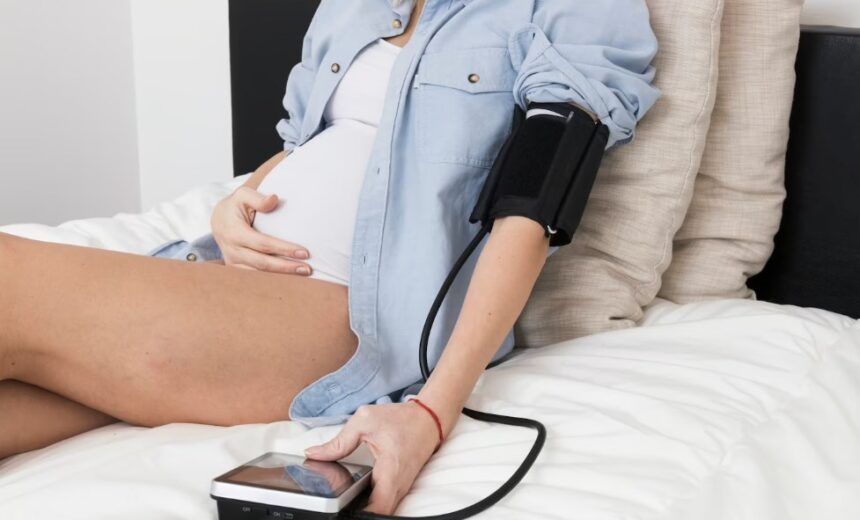Understanding the Duration of Postpartum Hypertension

Postpartum hypertension (also known as pregnancy-induced hypertension (PIH) postpartum) is a prevailing concern that many new mothers encounter. This condition, characterized by elevated blood pressure, can manifest during pregnancy or emerge following delivery. Although hypertension can affect anyone, postpartum hypertension specifically targets women in the immediate postpartum period.
The duration of PIH varies from woman to woman, and various factors can influence the healing time. Within this article, we will delve into the essence of postpartum hypertension, its underlying causes, the typical duration it lasts, available treatment options, as well as the potential complications and risks it carries.
Understanding Postpartum Hypertension: A Closer Look at High Blood Pressure After Giving Birth
Postpartum hypertension refers to the occurrence of elevated blood pressure following childbirth. This common condition can affect numerous women in the postnatal period. Although it primarily affects those who experienced gestational hypertension, preeclampsia, or chronic hypertension during pregnancy, even women with previously normal blood pressure levels can be susceptible.
Untreated PIH can pose significant health risks. Its potential complications include stroke, heart attack, kidney failure, and damage to vital organs. Therefore, it becomes crucial for women to recognize the symptoms associated with elevated blood pressure and promptly seek medical attention if needed.
Unveiling the Origins of Postpartum Hypertension
The precise cause of postpartum hypertension remains elusive, yet it is believed that significant hormonal fluctuations occurring during placental delivery can trigger this condition. These fluctuations prompt blood vessels to constrict, resulting in elevated blood pressure levels. Additionally, factors such as obesity, stress, and a family history of hypertension may contribute to the development of postpartum hypertension.

To mitigate the risk of postpartum hypertension, it is crucial for women to adopt and maintain a healthy lifestyle during and after pregnancy. This includes adhering to a nutritious diet, engaging in regular physical activity, and effectively managing stress levels.
Recognizing Symptoms and Receiving a Diagnosis
To ensure timely detection and appropriate management of postpartum hypertension, it is essential to recognize its symptoms and undergo a proper diagnosis.
PIH symptoms may include:
- Headaches;
- Swelling in the hands or feet;
- Breathing difficulties;
- Chest pain;
- Blurred vision.
It’s important to note that in many cases, women may not exhibit noticeable symptoms of postpartum hypertension. Therefore, monitoring blood pressure levels after childbirth becomes crucial. Diagnosis typically involves regular blood pressure measurements taken at intervals.
Attending postpartum check-ups with healthcare providers is vital for women to monitor blood pressure levels and promptly identify any signs of postpartum hypertension. Early detection allows for timely intervention and treatment, significantly reducing the likelihood of serious complications. These measures not only safeguard the mother’s well-being but also enhance health outcomes for both the mother and the baby.
Treatment and Prevention Measures
Treatment for elevated blood pressure often involves medication to lower blood pressure and minimize the risk of complications. In severe cases, hospitalization may be necessary for closer monitoring and specialized treatment.
Prevention Measures:
- Healthy Lifestyle: Maintaining a healthy lifestyle during and after pregnancy is crucial in preventing postpartum hypertension;
- Balanced Diet: Following a nutritious and well-balanced diet can help manage blood pressure levels;
- Regular Exercise: Engaging in regular physical exercise promotes overall cardiovascular health and can help lower blood pressure;
- Stress Management: Effectively managing stress levels through techniques such as relaxation exercises or seeking support can contribute to reducing the risk;
- Consultation with Healthcare Provider: Women with a history of hypertension or other risk factors should consult their healthcare provider to explore strategies tailored to their specific situation for reducing the likelihood of postpartum hypertension.
Postpartum hypertension is a common condition that affects numerous women after giving birth. It’s vital for individuals to be aware of the symptoms and promptly seek medical attention when necessary. With accurate diagnosis and appropriate treatment, women can recover from PIH and mitigate the risk of severe complications.

Understanding the Duration of Postpartum Hypertension
The duration can vary among women. While some may experience a swift recovery within days or weeks, others may require treatment to regulate their blood pressure levels. Multiple factors influence the healing process, including the severity of hypertension, prior history of hypertension or preeclampsia, and overall health status.
Typical Recovery Timeframe
Generally, most women recover from such an occurrence within six weeks after delivery. However, some may require several months or even a year to fully recuperate. Nourishing the body with a balanced diet, managing stress levels, and engaging in regular exercise can help expedite the recovery process.
When to Seek Medical Assistance
It is crucial to seek medical attention if blood pressure measurements remain elevated in the weeks following childbirth. Persistent hypertension can lead to serious health complications such as stroke or heart disease. Timely intervention from healthcare professionals is pivotal in managing PIH and minimizing the potential for long-term health issues.
Exploring Treatments for Postpartum Hypertension
The primary approach to treating elevated blood pressure involves the prescription of medications by doctors. Antihypertensive drugs are commonly utilized to lower blood pressure and prevent further complications. Medications that were effective in managing hypertension during pregnancy may also be suitable for postpartum treatment. However, breastfeeding mothers should consult their healthcare provider as certain medications can pass into breast milk and potentially impact the baby’s health.
Supporting Lifestyle Modifications
In conjunction with medical interventions, adopting healthier lifestyle habits can complement the treatment process and expedite recovery. Incorporating regular exercise, maintaining a well-balanced diet, and effectively managing stress levels can contribute to reducing blood pressure. Additional measures such as limiting salt and alcohol intake, prioritizing sufficient sleep, and quitting smoking can also minimize the risk of hypertension.
Home Blood Pressure Monitoring
Monitoring blood pressure at home proves to be an excellent strategy for postpartum mothers to actively manage hypertension. Consistently tracking blood pressure levels enables the early detection of any changes and assists healthcare providers in determining if adjustments to medication or monitoring are necessary.
Potential Complications and Risks
High blood pressure in mothers elevates the risk of developing severe complications, including heart attack, stroke, and organ damage. Chronic occurrences may lead to long-term implications such as kidney disease or chronic hypertension.
Moreover, PIH can impact the growth of the baby, particularly if the mother experienced hypertension during pregnancy. This condition may contribute to low birth weight or premature birth.
Long-Term Health Considerations
Postpartum hypertension can have enduring health consequences for both the mother and the child. Women with a history of hypertension should undergo regular check-ups to monitor the condition and prevent its reoccurrence later in life. Additionally, the child may face developmental risks and may require early intervention to address potential health issues stemming from low birth weight or premature birth.
In Conclusion
Navigating PIH can be a challenging journey for new mothers. However, with diligent monitoring and appropriate treatment, hypertension can be effectively managed.
Equipping oneself with an understanding of the symptoms, causes, duration, and treatment options associated with postpartum hypertension, along with awareness of potential complications and risks, empowers mothers to make informed decisions about their health and well-being. Promptly reaching out to healthcare providers at the first signs of hypertension can prevent long-term health problems and ensure a smooth recovery process.







